 Leading Blog | Posts by Category |
 Leading Blog | Posts by Category |
03.27.20

Restoring the Soul of Business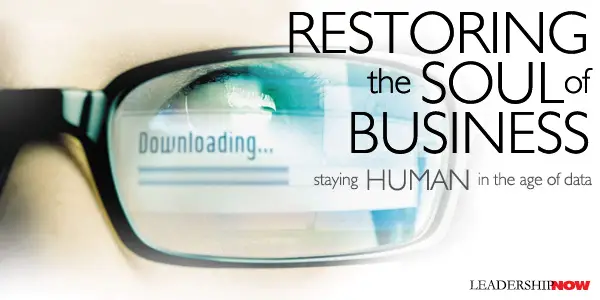
DATA without soul is harmful. Science, math, and data do not excuse us from thinking. Instead, they make it imperative that we learn to think more critically and combine it with our humanness to come to more measured conclusions. The story we create with the data makes all the difference. Rishad Tobaccowala is the chief growth officer at Publicis Group, a global advertising and communications firm. He says that flush with data, we risk losing something more valuable: what’s human. Rishad writes in Restoring the Soul of Business: Staying Human in the Age of Data, that we can have too much math and too little meaning. “Successful individuals and firms can never forget the importance of people, their emotions, the culture of the organization, and what cannot be measured. Successful people and companies combine the story and the spreadsheet, and by doing so, restore the soul of business.” It’s a balance. The 6-I Approach Extracting meaning and accurate insights from data is made better by implementing what Rishad calls the 6-I Approach. Interpret the Data Not all data is alike. “Develop hypotheses, search for patterns, look for outliers, create alternative scenarios to explain the information you’re receiving. Through interpretation you can enrich the data with meaning; you can identify the story it’s telling.” Involve Diverse People “Expand the group that examines the data. When you involve people with various skills and perspectives, you’re likely to receive a richer interpretation.” Interconnect to Larger Trends and Events How does the data relate to what you’re doing or to an emerging trend or a competitor’s product launch? “Making these types of connections helps you take the data one step further, determining if it’s going to have a short-term or long-term impact, if it’s suggesting the end of a trend or the beginning of a new one.” Give it context. Imagine and Inspire Solutions What possibilities does the data ignite? “Rather than allowing the data to limit options and actions, explore the solutions it might inspire. If the numbers show that your product category isn’t doing as well as it once did in Market Z, is there an emerging opportunity because the market still has potential and competition will be reduced because of this data?” Iterate “Data can spawn new and better data. Is there a test you might run based on the information you’ve gathered that can produce more insightful facts and figures?” Ask new questions of the data. Investigate People’s Experiences “In a given organization, you have hundreds or thousands of people with data-relevant insights because in the past—whether while part of your organization or with a previous employer—they experienced something applicable to the current information.” Sometimes new data is just an old story on a new context. Seven Keys to Staying Human Each of these sections is full of practices to help integrate them into our organizations—to make them more human. Talk About the Inconvenient (Tough) Truths Three of the most valuable assets in communicating are the following four-, five-, and six-letter words: data, trust, and intent. “Do you have good data that supports your point of view? Can you be or are you trusted? What is your intent? – i.e., why are you saying what you’re saying? Organizations must encourage trusted, well-intentioned, well-informed people to display this type of candor, no matter what their titles are? Address the Reality That Change Sucks People see change differently and are affected by change differently. “People won’t support and further change unless they perceive how they and their skills fit in. Employees need to see how the change strategy helps them grow, not just the organization.” When we are data-driven we see things in absolutes. Humans are more nuanced than that. Unleash Creativity by Inserting Poetry into the PowerPoint The spreadsheet “is not a clear window to view either the present or the future. Inherently, it’s backward-looking device that jails thinking within its cells. Within many organizations, highly innovative, potentially game-changing ideas are born regularly. Unfortunately, the left-brain environment of these organizations often starves these ideas of oxygen and they don’t survive.” Introduce art into your organization. “Creativity is how we manage our own change.” Recognize That Talent Does Not Work for Companies but Rather Companies Work for Talent Data tends to favor the organization rather than the employee. “Working for talent translates into three developmental actions: helping people create their niche, voice, and story.”
Diversify and Deepen Time Usage It is a mistake to allocate and measure time only in economic terms or numeric ways. The quality of how people spend their time is as important as the quantity of what they produce during that time. To get the most out of time, organizations need to sanction doing less and open spaces to do nothing. Schedule More Meetings Too often meetings are about the spreadsheet side of the business. “The received wisdom of minimizing meetings and only going to ones that create value for you is wrong. More meetings create more opportunities for productive relationships.” Rishad five types of meeting we should be having that are meaningful and relationship-focused. Upgrade Your Mental Operating System Organizations need to put a priority on mental self-improvement. “Provide them with the means and the encouragement to learn continuously—or rather, to learn and unlearn.” Rishad make this important point about balance. When there is balance between the spreadsheet and the story, people are more likely to form their own opinions and be creative. First, there is a need to balance ends and means. If the goal is to achieve a numerical goal at all costs, balance is missing; people will ignore rules and even laws to achieve goals. A second form of balance is recognizing that people have different skills and the company should not force consistency and conformity. Restoring the Soul of Business is a much-needed book. In a world awash in readily available data, we must never forget the story. The story is what makes the data so valuable. That will be the challenge of the future. Data is the commodity. The story differentiates. Rishad writes: My point isn’t to beat up on algorithms—they obviously are crucial in a digital age—but to suggest that if we leave organizational employees to their own devices (pun intended), they will be reactive and biased in their thinking. They won’t consider options beyond their own narrow beliefs; they will see the trends they’re exposed to rather than explore ones on the periphery; and they will fail to consider that their ideas might be wrong or outdated since their screens are confirming their biases. If we put too much trust in algorithms, we are faced with three big risks: “The first is when you forget that a human programmed an algorithm and so it has a built-in bias. Leaving it to itself means you are giving up agency. Second, no algorithm, which is about zeros and ones, can truly capture humans who are variable. Third, if you can add no value to an algorithm, you have no job.” 
Posted by Michael McKinney at 03:54 PM
01.27.20

Competing in the Age of AI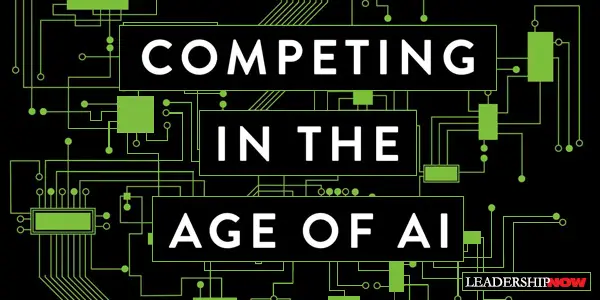
THE BIGGEST CHANGE being brought about by AI is not human replicas, but the emergence of digital operating models. These models aren’t the sexy, headline-grabbing side of AI, but they are profoundly affecting how we do business and the way leaders of the twenty-first century must think. Marco Iansiti and Karim Lakhani, professors at Harvard Business School, explore these changes in Competing in the Age of AI with examples of businesses in many industries. “When a business is driven by AI, software instructions, and algorithms make up the critical path in the way the firm delivers value.” And thus, how we think about the work we do and how we compete in the marketplace. The business plan describes the problem that is being solved for the customer—a reason to buy. The operating model is how that is accomplished. “The goal of the operating model is to deliver value at scale, to achieve sufficient scope, and to respond to changes by engaging in sufficient learning. If a business can grow in these areas it can increase its value. But here’s the thing. As these areas grow in a traditional business model, it also increases complexity and as a result, management challenges. At some point, the traditional model limits further growth. This is where AI is changing the nature of business and competition. With a digital operating model, “this new type firm is reaching new levels of scalability, achieving a vastly broader scope, and learning and adapting at a much faster rate than does a traditional firm. This is because the digital firm is transforming the critical path in the delivery of value.” This lengthy excerpt lays out the nature of the issue that leaders of traditional operating models face: Digital, AI-driven processes are more scalable than traditional processes. They enable greater scope (or variety), as they easily connect with a myriad of other digitized businesses, and they create powerful opportunities for learning and improvement, such as the ability to produce ever more accurate, complex, and sophisticated predictions and even gain fundamental understanding. In doing so, networks and AI are reshaping the operational foundations of firms, enabling digital scale, scope, and learning, and erasing deep-seated limits that have constrained firm growth and impact for hundreds of years. AI is breaking down the limits that are inherent in traditional operating models to drive new value, growth, and innovation. And when businesses with a digital foundation collide with more traditional firms, they can completely transform and reshape that industry. The authors provide case studies from the travel industry to the retail, entertainment, and automotive industries. The authors explain the issues faced when remaking a traditional operating model to exploit AI. They describe the journey to becoming an AI business. As we enter the age of AI, they point out five principles that we need to pay attention to: 1. Change Is No Longer Localized; It Is Systemic. “Inventions during the Industrial Revolution pertained to individual industries or at least clusters of industries. In contrast, digital transformation cuts across every industrial environment at the same time. Digital technology and AI are meeting an increasing variety of needs and enabling an incredible variety of use cases.” 2. Capabilities Are Increasingly Horizontal and Universal. “What is needed to compete in an AI-driven world has less to do with traditional industry specialization and more to do with a universal set of capabilities.” And this is especially important in a leadership context. “This new universality of capability reshapes a variety of operating tasks and reaches into strategy, business design, and even leadership. We are moving from an era of core competencies, differing from firm to firm and embedded deep in each organization, to an age shaped by data and analytics, powered by algorithms and hosted in the computing cloud for anyone to use.” 3. Traditional Industry Boundaries Are Disappearing Recombination Is Now the Rule. “The advice to executives in search of excellence was once to stick to their knitting and stay with businesses they knew. However, in the age of AI, organizations that cannot leverage customers and data across markets are likely to be at a disadvantage.” 4. From Constrained Operations to Frictionless Impact. “As digital operating models continue to displace traditional industrial processes, they also remove traditional operating constraints. This is why a new generation of firms has grown to unprecedented scale at unprecedented rates.” At the same time, even as frictionless systems “create unprecedented valuation multiples, digital scale, scope, and learning also create a slew of new leadership and governance challenges.” 5. Concentration and Inequality Will Likely Get Worse. In a pattern similar to what we saw in the Industrial Revolution, digital networks also lead to the “concentration of the flow of transactions and data, and from that to increased concentration of power and value.” All of this calls for—demands—a new degree of leadership wisdom. The implications of an AI-driven world are too complex and involve the exercising of values that only humans possess. Competing in the Age of AI is a fascinating book for not only implementing but understanding the transformations that are taking place in our digital world. 
Posted by Michael McKinney at 04:53 PM
01.09.20

The Future of AI: What Jack Ma and Elon Musk Are Missing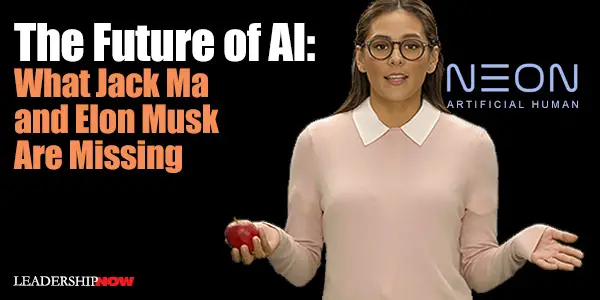
THERE IS LITTLE DOUBT that we underestimate the power of Artificial Intelligence. AI is quickly becoming a force in nearly every facet of human life. Serial Entrepreneur and Billionaire Elon Musk warns that AI will become much smarter than the smartest human. In a forum at the World Artificial Intelligence Conference held in China, on August 29, 2019, Elon Musk and Jack Ma exchanged differing views of the nature of AI. “There’s just a smaller and smaller corner of intellectual pursuits that humans are better than computers, and every year it gets smaller. Soon we will be far surpassed in every single way,” says Musk. Alibaba Group co-founder Jack Ma takes a different view. “When people talk about AI and say human beings will be controlled by machines—I never think that. It’s impossible. My view is that a computer may be clever. A human being is much smarter. Clever is very academic is knowledge-driven. Smarter is experience-driven.” Musk quickly disagreed. “Definitely not,” said Musk. “Computers are much smarter than humans on so many dimensions. The first thing you should assume is that we are very dumb and that we can definitely make things smarter than ourselves.” To which Ma responds, “Computer is only one of the collaborative tools that humans created. And computers are clever, but there will be more tools that human beings will create much cleverer than computers. “We invented the computer —I've never seen the computer invent a human being.” Ma is right: the creation is never greater than the creator. But even “clever” is not an attribute of a machine. Machines are not smart. They can access implanted memory faster and process data faster, but they are not smarter. Though they can be programmed to be and “learn” to be more lifelike, it is still artificial. Nevertheless, Musk’s concerns are warranted. Technology does outpace our ability to understand it and comprehend its consequences. Technology extends our reach, and most always, the intention is to make the world a better place. However, in every case, it is not the technology that is the issue, it is the people using it. What is always addressed too late is the character required to use it properly. Even with the basic AI we have today, we are seeing unprecedented changes that are beyond rendering certain skills and talents obsolete — they are reshaping what it means to be human. “If you assume any rate of improvement at all, the games will be indistinguishable from reality, you will not be able to tell the difference,” says Musk. And that is happening. At the Consumer Electronics Show this year, Samsung introduced the NEON project. Neons are like independent but virtual living beings that form memories and learn new skills, not AI assistants. Neons computationally create a “lifelike reality that is beyond normal perception to distinguish”—an artificial human. Isaac Asimov observes, “The saddest aspect of life right now is that science gathers knowledge faster than society gathers wisdom.” As AI increasingly impacts our lives, wisdom has become a fundamental leadership responsibility. It requires leaders to focus on character as a primary differentiator between man and machine.
Posted by Michael McKinney at 09:48 PM
09.02.19

Artificial Persuasion: The Invisible Brand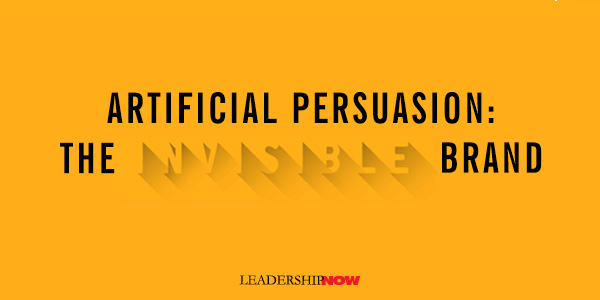
MASS MEDIA has been replaced by mass personalization through the rise of Artificial Intelligence. William Ammerman states in The Invisible Brand, “AI will play an increasingly important role in our lives in the years ahead as marketers turn vast amounts of computing power to the problem of influence people’s decisions.” Buried deep within the media we consume and the apps we use, unseen forces are working behind the scenes collecting data about us to pair with AI and digital advertising to influence everything we do. As a business, the challenge is how to best use this technology to promote ideas and products. As a consumer, the challenge is to understand how this technology is influencing us. Most of the time, it serves us well enhancing our lives and improving efficiency, and we welcome it. There are times when it feels like Big Brother is watching us. A better understanding of what is actually behind the technology will help us to ask better questions and respond in a measured and responsible manner. In a highly accessible way, Ammerman goes into great detail to explain how this technology is emerging and permanently altering the human-computer relationship. He identifies this emerging field as psychological technology, or simply psychotechnology. His focus is on marketing, but psychotechnology is working invisibly to reshape our behaviors in other areas of our lives. (Indeed, broadly speaking, everything we do is marketing.) Psychotechnology combines four areas of innovation: Personalization: Personalization is the norm in digital advertising. Machine learning connects all that data and allows marketers to tailor their messages just for you with your personality in mind. Persuasion: Marketers can use our innate human characteristics to influence our behaviors and thinking. Persuasion is not a new science, but today, it can be executed in new ways. “The science of persuasion is uncovering these unconscious reflexes that trigger specific behaviors.” Ammerman provides a fascinating look at how the science of persuasion is deployed behind the scenes in ways that influence our emotions and brain chemistry. Able to Learn: The amount and kind of information that is and can be gathered about our lives is astonishing. We don’t even think about it. Combined with AI, all this data gathering can be exploited through the power of machine learning. “Algorithms can learn by being fed data about what works and doesn’t work, and they can adapt in real-time to changing information.” 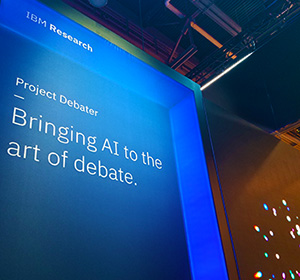 We can now have conversations with machines based on data about what we like, where we go, and who we know that is not unlike the conversations we would have with friends. Increasingly, people are creating emotional bonds with AI-powered machines. Our personal AI-powered tutor could help us to be continual lifelong learners—“a resource to help us learn the skills we need for our jobs, or even help us to identify the various flora and fauna we might spy on a mountain hike.” Ammerman raises questions regarding who owns our data, what is the government’s responsibility, should there be limits, and it’s use in political propaganda. For better or worse, the invisible brand is with us, and we have come to depend on it. “Behind all of this psychotechnology is an army of interests: corporations, governments, unions, politicians, religions, scientists, and universities, all vying for our hearts and minds. Through psychotechnology these brands operate invisibly, but collectively they are reshaping the market and the role of marketing.” Tim Berners-Lee remarked, “If you put a drop of love into Twitter, it seems to decay, but if you put in a drop of hatred, you feel it actually propagates much more strongly.” Perhaps we are hardwired to develop trust and connections slowly, being ever on the lookout for deceit and deception. A drop of love must be confirmed over and over across a long expanse of time to gain traction. We are slow to trust. Conversely, our instinct for survival has us on edge, always ready to respond aggressively to threats. A drop of hate triggers us more quickly, as we respond with less hesitation. This is an exploit the Invisible Brand can use against us by hacking our hate. To remain competitive, business must understand the forces shaping the marketplace. And consumers must educate themselves to the opportunities and dangers and develop the wisdom to think for themselves. Continue the discussion with these thought starters from William Ammerman: ▪ We’ve gone from delivering the same message to everyone at the same time through mass communications, to technology that can deliver different messages to every individual, on demand, through mass customization. 
Posted by Michael McKinney at 10:00 PM
07.10.19

How to Be an Engaging Leader in a World of Robotics, AI, and Digitization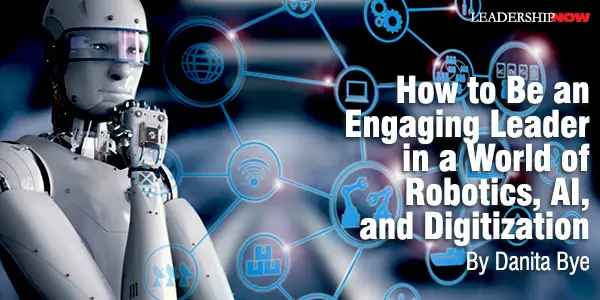
MANY of today’s leaders are saying: I know leadership is about people, not tasks; effectiveness, not efficiency. However, the rapid increase of robotics, AI, and digitization are a disruption. It’s leading us to increased depersonalization and disengagement with our employees. How do I keep the digital demands of today from overwhelming my business? I want to keep my best people engaged, remain competitive, and stay on the growth path! If these are your feelings, you are not alone! Many business leaders are perplexed by the task of leading in an ever-increasing technological world. Yes, we are leaders of people, and yet it feels as if technology and other digital demands keep us from investing in our most valuable resource, our people. In the midst of managing these exponential leaps in technology, there is a war for talent. We are challenged to attract, engage, and retain top-tier millennial talent – the fastest growing segment in our workforce. However, Millennials, the techno-wizards, are not necessarily happy either. Here’s the paradox: Millennials are stepping into a world where one of the things they are good at—technology—may well be one of the things that hurts them most and undercuts their ability to flourish. They are living in a world where the predictions are that robots will soon take over their jobs. It feels as if we’re getting mixed messages from the top. Do we need to choose between attracting and engaging top millennial talent and installing new, state-of-the-art technology? Not every industry needs the latest artificial intelligence, but everyone is feeling the pinch of staying on the leading edge of technology. How can we be an engaging leader in a world of robotics, AI, and digitization? The Benefits of Engaging Leadership According to the 2017 Gallup Workplace Report, employee disengagement is alarmingly high in America. They report that just over 30 percent of participants are engaged (love their jobs), 16 percent are actively disengaged (miserable and destroying what others are building), and 51 percent are not engaged (they’re just there). In 2016, the Society for Human Resource Management made a compelling case about the benefits that come from an engaging leadership approach: • 22 percent greater profitability
Millennials are reminding us of what the research shows – no matter how important the new AI or robotics system is, in order to attract, engage, and retain them, we need to do three important things. Prioritize the Person, as Well as the Technology “I want to be treated as an individual – not as a trend or a robot.” Listen deeply. Listening is a tangible action that engaging leaders employ to demonstrate that they value the Millennials in their sphere of influence. They listen…then collaborate on how they might support their emerging leader’s goals to leverage their strengths, nurture their natural skills, and achieve their career goals. Here’s the challenge. As experienced leaders, we have a wealth of knowledge, wisdom, and insight that we are excited to share with our younger counterparts. But what happens when we talk, and talk, and talk…and don’t listen? Our emerging leader loses trust. Then, they disengage. Why? Trust is at its lowest when we talk 75 – 80 percent of the time, and listen only 20 – 25 percent of the time. What might happen if we spent 20 – 25 percent of our coaching and managing time asking insightful, probing questions, and then listening? Practical experience has proven that active listening improves collaboration, deepens relationships, and boosts productivity. By prioritizing and seeking to understand what makes your emerging leader flourish, you spark engagement. Plus, you will gain even further insights from them on how to leverage technology to gain to tap new markets, gain market share, and enhance the customer experience. Align Vision and Values “I want to understand your vision and values so that I know how I’m making an impact. I want to be part of something bigger than the job you’ve hired me to do.” Tapping into the goals, dreams, and aspirations of their Millennials – and create align with their company’s vision and values – is a driver for engagement focused leaders. Emerging leaders often feel stuck and can’t see beyond the perceived drudgery of their ToDo List. They may struggle seeing how their everyday work has meaning and purpose. The result? Disengagement. Reverse this trend by helping them see how they, and the work they are doing, fits into your company’s larger purpose. The clearer the picture is to them on how they are helping your customers and how they are making the world a better place, the more engaged they will be. They will live with high regard for their work, bringing fresh, human compassion, insights, and connection to a high-tech world. Value Two-Way Mentoring “I want to be more than a digital number in your database who gets a monthly paycheck. I want leadership that values my opinion and is geared to my career development opportunities.” Two-way mentoring means that we seek not only to teach and train our emerging leaders, but also to learn from them. Millennials thrive when they get clear guidelines and feedback that shines a bright light on what they’re doing right. This creates a learning pattern for them of recognizing their strengths, re-creating it, and refining it. Bring them into brainstorming and problem-solving processes. Their insights can assist you in developing new products and services, as well as create openings in new markets. We might not want to admit it, but they have important insights for us to consider that test and rethink our own paradigms about how to lead well in the rapidly shifting world. Summary The disruption of digitization, robotics, and AI is here to stay. That does not mean that your role as a leader of people will become obsolete. In fact, your role will become even more indispensable. As the war for talent continues, you can come one step closer to winning that war by becoming an engaging leader. The time has come to start listening to the emerging leaders so that we learn about their strengths. Give your Millennial clarity on his or her role, and create a win-win scenario by establishing yourself as a leader who wants to learn. You have the experience and resources to counteract the depersonalization and disengagement phenomenon. Keep your best people engaged, remain competitive, keep up with the demands of technology, and be poised for growth!  She is a member of Forbes Coaches Council, is a leadership and sales development expert and author of the new book, Millennials Matter: Proven Strategies for Building Your Next-Gen Leader.
Posted by Michael McKinney at 10:20 AM
04.24.19

Is Your Organization Digitally Mature?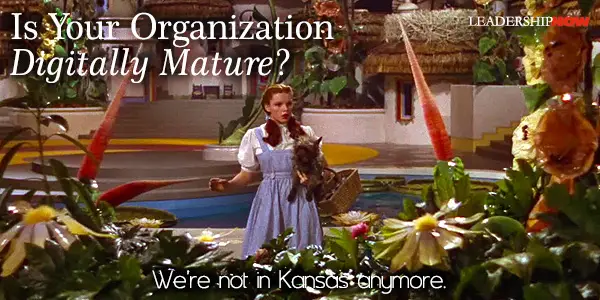
WE’RE not in Kansas anymore. Unlike Dorothy in the movie version of the Wizard of Oz, there’s no going back. Many companies experience digital disruption in the same way as the tornado in the Wizard of Oz—swept up by forces beyond their control. But the story is not about the tornado, but how they made their way through the strange new world they found themselves in. In the same way, digital disruption is not about the technology as much as it is about how companies can make their way through the new competitive environment they find themselves in. Digital disruption is more about the people than it is the technology. People are the focus of The Technology Fallacy by Gerald Kane, Anh Phillips, Jonathan Copulsky, and Garth Andrus. “It’s about how to manage disruption, adapt to disruption, and thrive in a world and a time marked by disruption.” The main problem facing organizations is not the pace of change itself but the “uneven rates of assimilating these technologies into different levels of human organization.” Technology changes faster than individuals can adopt it (the adoption gap); individuals adapt more quickly to that change than organizations can (the adaptation gap), and organizations adjust more quickly than legal and societal institutions can (the assimilation gap). Each of these gaps poses a different challenge for companies. Digital Maturity The authors introduce the concept of digital maturity. “Digital Maturity is about continually realigning your organization and updating your strategic plan to account for changes in the technological landscape that affect your business.” Digital maturity should be the goal that most companies should aspire to in order to compete in a digital world. They note that the idea of tightly aligning an organization's people, tasks, structure, and culture is not new; it plays out differently because the conditions under which those management principles operate has changed. Digital maturity is a gradual, ongoing process. In a digitally mature company, the digital strategy is a core part of the organization’s overall business strategy. Business should experiment with new technologies, but more importantly, they need to be able to “clearly articulate why they need to invest in these technologies or what business purpose they could serve.” Digital leaders need to focus on business value. Digital strategy isn’t just thinking of new initiatives that enable organizations to do business in the same way but slightly more efficiently. Instead, it involves fundamentally rethinking how you do business in light of all the digital trends occurring both inside and outside your organization. It involves identifying potential new services, sources of revenue, and ways of interacting with employees. What About Leadership? Does the essence of leadership really change in the digital age? Or are greater and greater levels of uncertainty causing us to forget the essentials and focus on the latest bright and shiny object? The fundamental principles of leaders never change. We tend to forget that in the face of rapid change. New environments demand a different emphasis. The authors rightly note, “Digital leadership is just leadership, albeit in a somewhat new environment.” But what is different? “Leaders cannot readily assume that any information can be kept private and must be prepared to deal with all situations publicly.” They shared this from the Australia and New Zealand Banking Group (ANZ): The second skill needed to be a great leader in today’s context is to be inherently curious. Today’s leaders need to lead through influence rather than through command and control. That’s quite hard for people who have really only had one quiver [sic] in their leadership bow, which is command and control. What they meant was arrow but point well taken. I liked the metaphor. The point they make regard command and control has always been so, but in the industrial age you could get away with it, so it has become the baggage we have to deal with. What Skills Do Digital Leaders Need? From their research, the most important skill is transformative vision and a forward-looking perspective. This includes not just knowledge of markets and trends, but how they are evolving and how the business should respond. It would be the ability to know what is foundational to the business and what changes are relevant and might impact that base. Next is digital literacy. That is, understanding the general principles of how a technology works and thus the possibilities that come from so that one can determine if a particular technology is or is not relevant for certain business applications. It is difficult to provide purpose and direction if you have no idea how or why a technology will impact your business. A leader must be change-oriented or open-minded. Willing to adapt and comfortable with a changing environment. Beyond this, a leader must demonstrate the ability to deliver and decisively lead the organization into the future. One other key difference to leadership in a digital age: where leadership is found within the organization. In the twentieth century hierarchical corporation, people looked only to the top of the org chart for leadership. With the pace of change, that is no longer practical—nor is it always where you can find effective leadership. When we talk about leadership, we are referring to leadership at all levels of the organization. Digital Talent Attracting and keeping digital talent is a challenge for many organizations. With the pace of change and innovation, not only must individuals have a growth mindset, but organizations must also create a culture of growth and continuous learning. The focus for all needs to be on lifelong learning. Even for the digital natives, time marches on. While older generations have much to learn from the millennials, the fact that they are early adopters doesn’t mean they necessarily know how to adapt that technology in an organizational setting. “Millennials are not inherently digital, at least not in an organizational sense. They may have adopted technology individually, but they will not instinctively know how to help your company adapt. Even if they come out of college more digitally minded than their older counterparts, that edge will atrophy without continuous learning and a growth mindset.” Continuous learning is your best defense in a changing environment. The authors go on to discuss the conditions for successfully adapting to digital disruption that most organizations will need to create. They address such topics as organizing, cross-functional teams, enabling stronger collaboration, cultivating a more experimental mindset, and an approach for measuring digital maturity in your organization. 
Posted by Michael McKinney at 07:34 AM
09.11.18

Smart Business is Business Redefined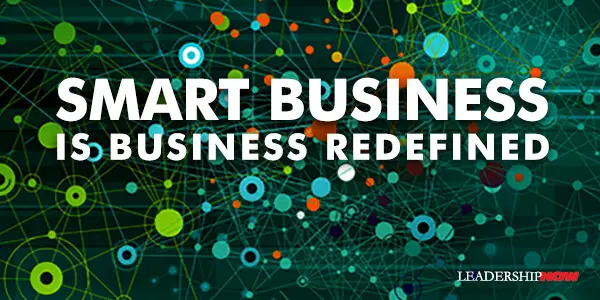
I In 2016, Alibaba facilitated sales of $15 billion. In 2016, Black Friday and Cyber Monday saw less than 3.5 billion dollars. In 2017, three minutes after the day opened at midnight, $1.5 billion in sales had been transacted. At the peak, Alibaba’s technology platforms processed 325,000 orders and 256,000 payments every second. It’s amazing when you think that VISA’s stated capacity as of August 2017 was 65,000 payments per second globally. Logistics? “Just twelve minutes after the midnight start, the first package arrived at a customer’s door in Shanghai. Three minutes later, a woman in Ningbo on China’s Pacific coast received the first imported package. Before 9:30 a.m., a hundred million packages had already shipped.” Singles Day is a technological marvel. But it would be wrong to think of Alibaba as China’s Amazon. To think of it this way “obscures Alibaba’s breakthrough business model and the window it provides on how the economic scene is evolving.” The technology and business model Ming Zeng, the chairman of the Academic Council of the Alibaba Group, describes in Smart Business: What Alibaba’s Success Reveals About the Future of Strategy. Unlike Amazon, Alibaba is not even a retailer in the traditional sense—we don’t source or keep stock, and logistics services are carried out by third-party service providers. Instead, Alibaba is what you get if you take every function associated with retail and coordinate them online into a sprawling, data-driven network of sellers, marketers, service providers, logistics companies, and manufacturers. Zeng summarizes the formula for smart business with this simple equation: “That simple equation reveals what is behind Alibaba’s success and captures everything you need to know about business in the future. Success is strength in both networks and data.” In its broadest sense, network coordination is the breaking down of complicated business activity so that groups of people or firms can get it done more effectively. Smart business then, is when all participants involved in achieving a common goal are coordinated in an online network and use machine-learning technology to efficiently leverage data in real-time to generate relevant responses. A case in point: 25-year-old Zhang Linchao is the head of China’s online clothing brand, LIN Edition. Turning her clothing hobby into a business, she turned to Taobao, Alibaba’s Chinese e-commerce platform. In 2015, she prepared to sell a batch of 15 new clothing items at 3:00 p.m. Ten of thousands so of fans are waiting for the sale to begin having already seen previews of this sale on social media. She expects to sell several thousand items but has only had 1000 pieces in stock—total. At 3:00 p.m. 60,000 users are visiting the store. Within one minute, everyone one of the fifteen clothing items sells out. Now preorders are sold. By 3:45 p.m., she has sold more than 10,000 items with each customer spending an average of $150 per order. Linchao has created an on-demand business—but at mass production price points. What is remarkable is that she finds her customers on social media, keeps almost no inventory, and owns no factories. Yet the customer has the product in 7 to 10 days. The business model is efficient and responsive. Smart businesses like LIN and many others rely heavily on machine-learning technology to achieve scale and manage complexity. Alibaba uses “technology to coordinate business activity across a nearly unlimited number of interconnected parties.” A business strategy is no longer based on competition, but coordination. Routine decisions are made automatically by machines driven by data. “Organizations are no longer static, hierarchical structures that need managing and controlling, but rather are dynamic, fluid networks of interconnected players that must be engaged by mission and opportunity.” Strategy Is About Learning, Not A Plan Strategy in a smart business is not long-term or short-term planning. It’s not planning at all. It’s more like learning. Strategy is continually updated by continuous real-time experimentation and customer engagement, which “creates feedback, which leads to adjustment of the vision, which in turn guides new experiments.” Can we run a business like an algorithm? What Does this Mean for Organizations? The Creativity Revolution is here. Organizations in the Creativity Age will focus on creativity and innovation. “An organization’s goal is to improve the efficiency of innovation founded on human insight and creativity.” This cannot be managed in the traditional way. A smart business is “no longer a vessel for conveying orders from the top. It is a vacuum sucking up information about its environment and then generating and coordinating effective responses. The job of leadership is not to manage this experiment, but to make it possible and boost its success rate.” Think enabling not managing. Through enabling mechanisms, management provides the necessary conditions to tackle business problems through innovation as opposed to the execution of tried-and-true procedures. This means managers must now focus on things like articulating the mission and providing the environment that attracts the right collaborators, supplying the tools for them to experiment and scale successful ideas, and providing a market to assess the innovation’s success. Instead of micromanaging the firm, management creates the organization’s architecture to run itself. To do this you need a strong culture and the people that fit that culture. “Hiring is the single most important thing a company can do to preserve culture.” Culture “works to segregate as much as it does to bring people together.” To that end, Alibaba has HR workers randomly assigned to interview employee candidates called, “chief olfactory officers. Their job is to sniff out the match between candidates and the strong corporate culture.” From Zeng’s perspective, “the individual has more potential than maybe at any other time in history.” New technologies can free individuals from static organizations. New technologies “need not swallow the individual, but instead can propel you forward toward greater heights.” Smart Business is one of the most fascinating books you’ll read this year on strategy and the future of business. At the very least it will expand your perspective. Zeng details the principles and practices that companies need to become smart businesses and the implications to the organization of those implemented principles and practices. Singles Day is an example of what is possible when networks and data are brought together at the same time. “Thousands of companies come together seamlessly and instantly to provide millions of customers with what they want. Unimaginable scale is possible when businesses are smart.” 
Posted by Michael McKinney at 07:35 AM
07.06.18

What Is the Role of Leaders in Emerging Technology?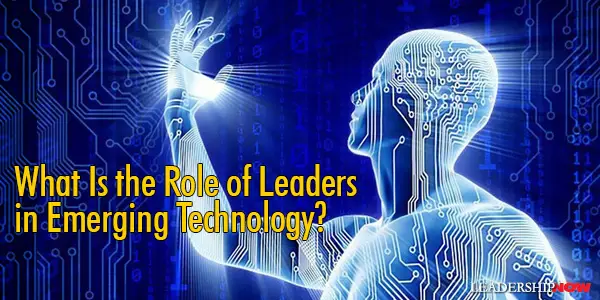
O Technology is capable of doing great things. But it doesn’t want to do great things. It doesn’t want anything. That part takes all of us. It takes our values and our commitment to our families and our neighbors and our communities, our love of beauty and belief that all of our faiths are interconnected, our decency, our kindness. For a leader to be that candle they need to be able to create context by communicating across disciplines. They need to be able to share ideas to take advantage of all of the information that is available and put it to a creative solution. In short, leaders will need to define focus and create meaning. An emphasis on communication will be essential for building a stable narrative and a practical relationship with technology throughout an organization or team. 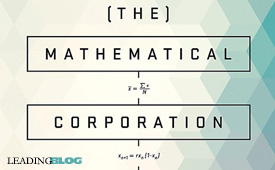 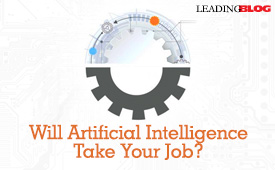
Posted by Michael McKinney at 08:16 AM
07.10.17

The Mathematical Corporation
Y A mathematical corporation is one that takes advantage of machine intelligence by collaborating with it to achieve leading-edge results. It will require a shift in your thinking. “As a leader,” say Josh Sullivan and Angela Zutavern in The Mathematical Corporation, “you need to evolve your focus to excelling through imagination, creativity, reasoning, and problem structuring.” Leading in the era of the mathematical corporation means learning to work with the machine to investigate mountains of data not by braking them down, but by keeping them together to mine insights never before imaginable. It means being able to distinguish what machines are good at doing from what people are good at doing. When people and machines are appropriately paired we can explore heretofore impossible strategies and execute incredible solutions. Machines will not replace people but we will need to develop and capitalize on some uniquely human skills. “People will continue to be better than machines at many of the loftiest cognitive tasks, like asking questions to clarify a problem, composing experiments to test hypotheses, and drawing on truths in one discipline to elicit insights in another.” Because of the machine’s ability to synthesize vast amounts of data, it would be wise to question your own judgments when machines offer a different conclusion from your own. Machines, for example, can recognize patterns better than we can. That said, “computers don’t know the cause of a pattern. They don’t have the human appetite to get to the bottom of the matter, and they don’t ask, ‘Just how does cause A lead to effect B?’ They learn, infer, and have high recall accuracy, but they don’t know the story of cause and effect. So, the task of taking a cause-and-effect understanding of a business system and crafting a strategy from it remains a people job.” Getting the Questions Right While Big Data adds complexity, it is only a problem if you don’t know how to mine it for value. The key skill for leaders is to be able to ask better questions than to offer solutions. Asking the right questions is critical. Poor questions lead to questionable insights. “That’s why as a leader, you need to remain at the tip of the process, seeing the world in a much broader and more differentiated way than others.” Not only asking the right questions but removing our own biases from them, will bring us breakthrough insights and more nuanced answers. Another issue we will have to work through is not projecting our limitations and constraints on the machine. Although we have a mental model that we filter the world though, we must be careful not to constrain the machine—our questions—in the same way. What About Intuition? In the mathematical corporation, the role intuition will shift from judging reality to judging models. “No matter your feeling on intuition, its role is destined to shift to a smaller, if still critical position. As machine intelligence converts implicit understanding to exploit facts, replaces implicit assumptions with data-givens, counters biases with hard evidence, we have to admit the superiority of the cold facts encoded in 1s and 0s.” Often it will require a leap of faith on our part. We will need to learn to ask bigger questions and questions that will lead us to better questions. The best machine collaborators will see this as a learning journey. “Conventional strategic planning practice calls for a relentless search for answers during a detailed analysis of context and a relentless analysis of the opportunity to find the right answer in one go. But when the answer is over the horizon, no amount of analysis of the landscape up front will reveal it. You need to go on a learning journey—sailing to the far shores to find the best answer.” It requires a commitment to a cycle of questioning and learning, questioning and learning. As digital technologies continue to develop and improve, leaders will need to become wise and discerning leaders of machines. Leaders will not only be expected to use this technology to their advantage to solve their own organizational issue but to help answers the questions that exist beyond their own walls.  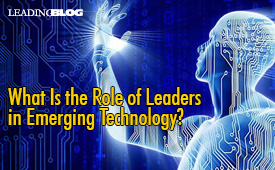 
Posted by Michael McKinney at 05:24 PM
|
BUILD YOUR KNOWLEDGE
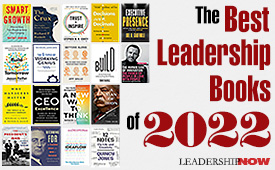

How to Do Your Start-Up Right STRAIGHT TALK FOR START-UPS 
Grow Your Leadership Skills NEW AND UPCOMING LEADERSHIP BOOKS 
Leadership Minute BITE-SIZE CONCEPTS YOU CAN CHEW ON 
Classic Leadership Books BOOKS TO READ BEFORE YOU LEAD |
|